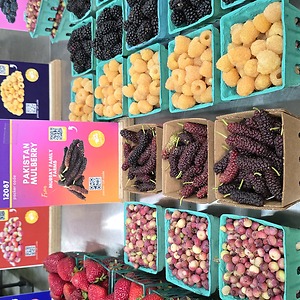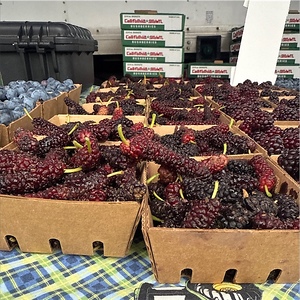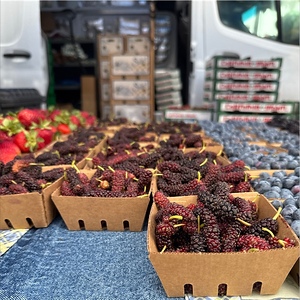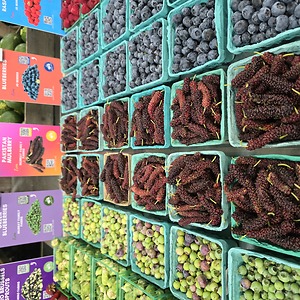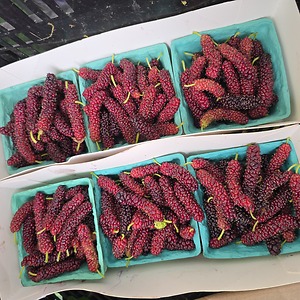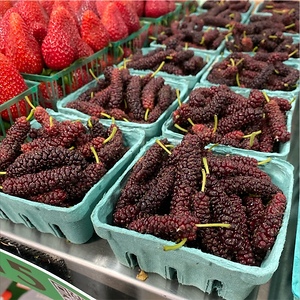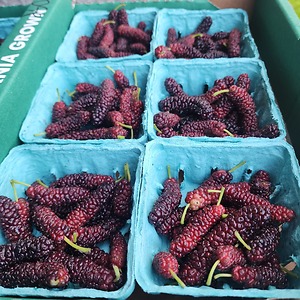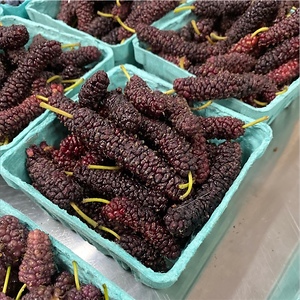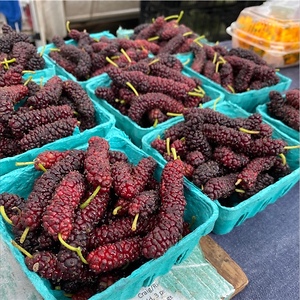


Pakistan Mulberries
Estimated Inventory, bskt : 0
Description/Taste
Pakistan mulberries are one of the largest mulberry varieties, averaging 7 to 10 centimeters in length, and are aggregate fruits composed of tiny individual drupes clustered around a central stem. Each mulberry has a long, narrow, and cylindrical shape with a plump nature and rounded ends. The fruit’s surface is pebbled and bumpy due to the fusion of the tiny drupes, and the skin is thicker than other varieties, showcasing a smooth, taut, and semi-glossy appearance. The shininess will fade into a dull, almost matte look as the fruit matures and sweetens. Pakistan mulberries ripen from green, ruby to a dark purple-red, almost black hue. Underneath the surface, the flesh is firm but soft and semi-aqueous with a succulent consistency. There is also a stringy core found in the center of the flesh. This core is edible but does not have flavor. Some consumers eat the core, while others choose to pull the fruit through their teeth to scrape the flesh from the core, then discard it. Pakistan mulberries are low in acidity and juice, creating a concentrated mild, sweet, fruity, and jammy flavor reminiscent of blackberries and raspberries.
Seasons/Availability
Pakistan mulberries are available in the spring through mid-summer.
Current Facts
Pakistan mulberries, botanically classified as Morus macroura, are a specialty variety belonging to the Moraceae family. The elongated fruits grow on deciduous trees generally pruned to reach nine meters in height and are an early-ripening cultivar. Pakistan mulberries are also known as Himalayan mulberries, Shahtoot, Long Mulberries, and Tibetan mulberries. The variety is favored among growers for its self-fertile, fast-maturing nature, producing fruit 2 to 3 years after planting, drought tolerance, and continuous harvest throughout the season. The trees can also live to be several hundred years old, still bearing fruit into their elder years. Pakistan mulberries were spread worldwide in the late 20th century and became a favored cultivar of mulberry enthusiasts for the fruit’s size, flavor, and consistency. The fruits contain lower levels of juice and acidity, creating a concentrated texture and flavor suited for baked goods, jams, and sauces. The variety is also not likely to stain clothing and fabric as the fruits are less juicy than other dark red-purple cultivars. Pakistan mulberries have firmer skin, allowing the fruits to last for a few days longer than different varieties, an important trait when utilized by chefs. Despite their growing popularity, Pakistan mulberries are not widely sold in grocers and supermarkets and are localized to farmers markets, specialty distributors, or grown in home gardens.
Nutritional Value
Pakistan mulberries are a source of fiber to regulate the digestive tract and vitamin C to strengthen the immune system while reducing inflammation. The fruits also provide iron to develop the protein hemoglobin for oxygen transport through the bloodstream, potassium to balance fluid levels within the body, vitamin K to assist in faster wound healing, and other nutrients, including vitamin E, manganese, vitamin A, folic acid, B vitamins, and riboflavin. The dark red-purple pigments in the fruits are created from the presence of anthocyanins, a type of antioxidant that protects the cells against free radical damage. Mulberries are also known for containing resveratrol, a plant compound that acts as an antioxidant in the body and is being studied for its potential disease-fighting and anti-aging properties.
Applications
Pakistan mulberries have a sweet, fruity flavor suited for fresh and cooked preparations. The fruits can be consumed straight out of hand, and the core is edible, but most consumers choose to discard it. Pakistan mulberries can be blended into smoothies or pressed and strained to create a sweet juice. This juice can be consumed as is, or it can be incorporated into cocktails. Mulberries can also be mixed into vinaigrettes for salads, simmered into syrups to drizzle over ice cream or yogurt, cooked into jams and jellies for bread and cheese, or made into pastes that can be stuffed into baked goods. The variety is specifically valued for its concentrated, drier flavor, adding flavoring to baked goods and desserts, including pies, cakes, tarts, muffins, crisps, and cobblers. They can also be blended and frozen into ice cream. Beyond sweet preparations, Pakistan mulberries can be cooked with red wine and spices to create a sauce for savory dishes, mainly roasted meats. Pakistan mulberries pair well with herbs such as thyme, sage, basil, and mint, vanilla, cheeses including chevre, burrata, and cream, meats such as pork, duck, and beef, cherries, berries, and stone fruit. Fresh, unwashed Pakistan mulberries are highly perishable and will keep for 2 to 3 days when stored in the refrigerator on top of paper towels and covered in plastic wrap. The fruits can also be dried or frozen for extended use.
Ethnic/Cultural Info
In Pakistan, mulberries are popularly incorporated into beverages or simmered into jams and chutney. The fruits offer an intensely pigmented, fruity, and sweet juice consumed as a refreshing reprieve on hot summer days. Mulberries are also commonly cooked into a chutney and served with cheese and flatbread. It is rumored that mulberry chutney has been found in a 700-year-old recipe in Pakistan known as burosh sapik, and the chutney was traditionally served with paneer, a cheese made from curdled milk and lemon juice, and parantha, a type of flatbread that can be stuffed with various ingredients. In the modern-day, mulberry chutney is a seasonal delicacy also consumed in India. Mulberry trees are a common backyard tree and provide high quantities of fruits. At the end of the season, home chefs gather the fruits and cook them into homemade mulberry chutney, frequently served with toast or crackers, spread over cheese, or used in savory main dishes.
Geography/History
Pakistan mulberries are native to the forests of Pakistan and in the Himalayan Mountains spanning across India, Tibet, and China. Much of the origins of this variety are unknown, but the first Pakistan mulberries recorded were found in Islamabad, the capital of Pakistan. In 1986, USDA Plant Introduction Officer George A. White obtained cuttings of Pakistan mulberries from Islamabad at the request of Mike McConkey, owner of Edible Landscaping in Afton, Virginia. When the cuttings were sent from the Pakistan Agriculture Research Center in Islamabad to the United States, they were not labeled, rendering the cuttings nameless. The USDA decided to name the variety after its country of origin, Pakistan, and since this naming, the descriptor Pakistan mulberries is the primary label given to the variety. Today Pakistan mulberries are grown throughout the Middle East and Central Asia, available through local markets and foragers. The variety has also been introduced into the United States, where it is cultivated as a home garden variety. In southern California, several small-scale commercial growers offer the variety through farmers markets.
Recipe Ideas
Recipes that include Pakistan Mulberries. One



